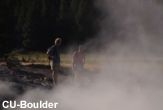Creatures Survive Environment that Dissolves Nails

Life once again proves its resiliency.
Scientists from the University of Colorado have found bacteria that live in the rocks of a hot, acidic environment in Yellowstone National Park.
Such extremophiles- organisms that can tough it out at sub-zero temperatures or with little water - are the cat's meow to astrobiologists, who want to determine the origin of life here on Earth, as well as estimate good spots to look for life elsewhere.
The new microbes were discovered in Norris Geyser Basin - considered to bethe most active area in Yellowstone. Temperatures are around 95 degrees Fahrenheit, and acid seeps into the stone.
"The pores in the rocks where these creatures live hasa pH value of one, which dissolves nails," said Norman Pace. "This isanother example that life can be robust in an environment most humans view as inhospitable."
Like a miner looking for gold, Pace's co-author Jeffrey Walker discovered the new microbe community in 2003 when he broke apart a chunk of sandstone-like rock and noticed a green band just beneath the surface.
"It was one of those 'eureka' moments," he said.
Get the world’s most fascinating discoveries delivered straight to your inbox.
The researchers used a kind of genetic screening to identify the critters in the rock.? The most abundant microbes, surprisingly, were a new species of Mycobacterium.? Bacteria from this group, which can cause tuberculosis and leprosy, had never been seen around a geyser before.
Besides being "pretty weird," these and other bacteria apparently leave fossil imprints in the rocks they inhabit.? These "biosignatures" could be red flags for life in past or present geothermal environments on other planets, like Mars.
"The prevalence of this type of microbial life in Yellowstone means that Martian rocks associated with former hydrothermal systems may be the best hope for finding evidence of past life there," Walker said.
The research, which was funded by the National Science Foundation and NASA, is reported in the April 21 issue of Nature.



